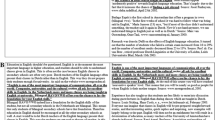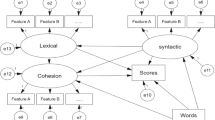Abstract
Using Biber’s (1988) multidimensional analysis, this study investigates textual variation in second language (L2) learners’ writing at different proficiency levels, and attempts to identify any developmental progression. The study used a corpus of 5200 argumentative essays written by 2600 students learning English as an L2. The results indicate that advanced L2 writing is fundamentally different from less advanced L2 writing: Advanced learners’ writing is closer to native speakers’ written discourse, while less advanced learners’ writing is closer to native speakers’ spoken discourse. The patterns of development vary across different sets of textual features. Informational (as opposed to involved) production and impersonal (as opposed to nonimpersonal) style showed gradual development as the learners’ proficiency increases. Nonnarrative (as opposed to narrative) production, elaborated (as opposed to situation-dependent) reference, and overt expression of persuasion did not show significant differences across the proficiency levels. The article offers pedagogical implications for practices of L2 writing instruction.

Similar content being viewed by others
Notes
When the reliability of the tool was tested using the Lancaster-Oslo-Bergen (LOB) and Brown corpora, Nini (2015) reported that, in both cases, MAT was largely successful in replicating the results of Biber’s (1988) analysis (see the replicated mean dimension scores of 13 text types of the LOB corpus and Brown corpus, respectively, reported in Nini’s manual, pp. 9–16). The correlation between the dimension scores computed by MAT and by Biber indicates a successful replication (r = .973, p < .001). Small discrepancies can be attributed to the difference of the POS taggers used by MAT (Stanford Tagger) and by Biber (unknown).
Note that the current study did not conduct a new factor analysis and did not establish new textual dimensions based on the ICNALE corpus. Instead, similar to Crosthwaite (2016), this study uses Biber’s (1988) factor analysis and his textual dimensions. Because the corpus used in this study consists only of argumentative essays, rather than various genres, applying a factor analysis to this highly constrained text corpus would be unlikely to inform us of more than identifying factors, yielding less generalizable interpretations.
It should be noted that the learners’ scores on Dimension 4 (being overtly persuasive) are much higher than any found by Biber (1988) for any type of discourse, which could also be due to the topic effect (argumentative essay). The subsequent analysis of the native group’s essays found scores of over 8 on Dimension 4 (Part-time Job: M = 8.04, SD = 5.47; Smoking: M = 9.01, SD = 6.04), which was also higher than any of the scores for Biber’s text types. This finding indicates that explicit persuasive intent is also overtly shown in the essays in this corpus.
References
Ai, H., & Lu, X. (2013). A corpus-based comparison of syntactic complexity in NNS and NS university students’ writing. In A. Díaz-Negrillo, N. Ballier, & P. Thompson (Eds.), Automatic treatment and analysis of learner corpus data (pp. 249–264). Amsterdam: John Benjamins.
Baayen, R. H. (2008). Analyzing linguistic data: A practical introduction to statistics using R. Cambridge: Cambridge University Press.
Becker, A. (2010). Distinguishing linguistic and discourse features in ESL students’ written performance. Modern Journal of Applied Linguistics, 2, 406–424.
Biber, D. (1988). Variation across speech and writing. Cambridge: Cambridge University Press.
Biber, D., Conrad, S., Reppen, R., Byrd, P., & Helt, M. (2002). Speaking and writing in the university: A multidimensional comparison. TESOL Quarterly, 36, 9–48.
Biber, D., & Gray, B. (2013). Discourse characteristics of writing and speaking task types on the TOEFL iBT test: A lexico-grammatical analysis (TOEFL iBT research report 19). Princeton, NJ: Educational Testing Service.
Biber, D., Gray, B., & Poonpon, K. (2011). Should we use characteristics of conversation to measure grammatical complexity in L2 writing development? TESOL Quarterly, 45, 5–35.
Biber, D., Gray, B., & Staples, S. (2016). Predicting patterns of grammatical complexity across language exam task types and proficiency levels. Applied Linguistics, 37, 639–668.
Crosthwaite, P. (2016). A longitudinal multidimensional analysis of EAP writing: Determining EAP course effectiveness. Journal of English for Academic Purposes, 22, 166–178.
Ferris, D. R. (1994). Lexical and syntactic features of ESL writing by students at different levels of L2 proficiency. TESOL Quarterly, 28, 414–420.
Frase, L. T., Faletti, A., Ginther, A., & Grant, L. (1999). Computer analysis of the TOEFL test of written English. Princeton, NJ: Educational Testing Service.
Friginal, E., & Hardy, J. A. (2014). Conducting Biber’s corpus-based multi-dimensional analysis using SPSS. In T. Berber-Sardinha & M. Veirano-Pinto (Eds.), Multi-dimensional analysis, 25 years on: A tribute to Douglas Biber (pp. 297–316). Philadelphia, PA: John Benjamins.
Friginal, E., & Weigle, S. (2014). Exploring multiple profiles of L2 writing using multi-dimensional analysis. Journal of Second Language Writing, 26, 80–95.
Grace-Martin, K. (2019). Specifying fixed and random factors in mixed models. Retrieved from https://www.theanalysisfactor.com/specifying-fixed-and-random-factors-in-mixed-models/. Accessed 27 Mar 2019.
Grant, L., & Ginther, A. (2000). Using computer-tagged linguistic features to describe L2 writing differences. Journal of Second Language Writing, 9(2), 123–145.
Ishikawa, S. (2019). The ICNALE: The international corpus network of Asian learners of English. Retrieved from http://language.sakura.ne.jp/icnale/. Accessed 27 Mar 2019.
Jarvis, S., Grant, L., Bikowski, D., & Ferris, D. (2003). Exploring multiple profiles of highly rated learner compositions. Journal of Second Language Writing, 12, 377–403.
Lu, X. (2011). A corpus-based evaluation of syntactic complexity measures as indices of college-level ESL writers’ language development. TESOL Quarterly, 45, 36–62.
Nation, I. S. P., & Beglar, D. (2007). A vocabulary size test. The Language Teacher, 31(7), 9–13.
Nini, A. (2015). Multidimensional analysis tagger (version 1.3). Retrieved from http://sites.google.com/site/multidimensionaltagger. Accessed 27 Mar 2019.
Ortega, L. (2003). Syntactic complexity measures and their relationship to L2 proficiency: A research synthesis of college-level L2 writing. Applied Linguistics, 24, 492–518.
Rosenthal, R., & Rosnow, R. L. (1984). Essentials of behavioral research: Methods and data analysis. New York, NY: McGraw-Hill.
Shaw, P., & Liu, E. T. (1998). What develops in the development of second-language writing? Applied Linguistics, 19, 225–254.
Staples, S., Biber, D., & Reppen, R. (2018). Using corpus-based register analysis to explore the authenticity of high-stakes language exams: A register comparison of TOEFL iBT and disciplinary writing tasks. The Modern Language Journal, 102, 310–332.
Taguchi, N., Crawford, W., & Wetzel, D. Z. (2013). What linguistic features are indicative of writing quality? A case of argumentative essays in a college composition program. TESOL Quarterly, 47, 420–430.
Weigle, S. C., & Friginal, E. (2015). Linguistic dimensions of impromptu test essays compared with successful student disciplinary writing: Effects of language background, topic, and L2 proficiency. Journal of English for Academic Purposes, 18, 25–39.
Winter, B. (2013). A very basic tutorial for performing linear mixed effects analyses (Tutorial 2). Retrieved from www.bodowinter.com/tutorial/bw_LME_tutorial2.pdf. Accessed 27 Mar 2019.
Wolfe-Quintero, K., Inagaki, S., & Kim, H. Y. (1998). Second language development in writing: Measures of fluency, accuracy, and complexity (report no. 17). Honolulu: University of Hawaii Press.
Acknowledgements
This work was supported by the Ministry of Education of the Republic of Korea and the National Research Foundation of Korea (NRF-2016S1A5A2A03926788).
Author information
Authors and Affiliations
Corresponding authors
Additional information
Publisher's Note
Springer Nature remains neutral with regard to jurisdictional claims in published maps and institutional affiliations.
Appendices
Appendices
Appendix 1: The ICNALE’s writing instructions
Do you agree or disagree with the following statements? Use reasons and specific details to support your opinion | |
Topic 1: It is important for college students to have a part-time job | |
Topic 2: Smoking should be completely banned at all the restaurants in the country | |
Instructions | |
1. Clarify your opinions and show the reasons and some examples | |
2. You can use 20–40 min for each essay. This means that you have 40 to 80 minutes to complete two essays. Do not finish too early or spend too much time | |
3. You must use MS Word or a similar word processor | |
4. Do not use dictionaries or other reference tools | |
5. Do not plagiarize anyone else’s essays | |
6. The length of your single essay should be from 200 to 300 WORDS. Too short or too long essays cannot be accepted. You can check the length of your essay using the word count function of MS Word | |
7. You must run spell check before completing your writing |
Appendix 2: L2 argumentative essay examples 1–10
Dimension 1 (Topic 1: part-time job): Examples 1–3

Note. Positive features are highlighted in red; negative features are highlighted in blue; [AMP], amplifier; [BEMA], be as main verb; [CONT], contraction; [FPP1], first-person pronoun; [JJ], attributive adjective; [NN], noun; [PIN], preposition; [PIT], pronoun it; [POMD], possibility modal; [PRIV], private verb; [SPP2], second-person pronoun; [VPRT], present tense; [THATD], subordinator that-deletion; [VPRT], present tense.
Dimension 5 (Topic 2: smoking): Examples 4–6

Note. Positive features are highlighted in red; [BYPA], by-passive; [CONJ], conjunct; [OSUB], other adverbial subordinator; [PASS], agentless passive.
Dimension 3 (Topic 2: Smoking): Examples 7–8

Note. Positive features are highlighted in red; negative features are highlighted in blue; [NOMZ], nominalization; [PHC], phrasal coordination; [PIRE], pied-piping relative clause; [TIME], time adverbial; [RB], total adverb; [WHSUB]; wh-relative clause on subject position.
Dimension 4 (Topic 2: smoking): Examples 9–10

Note. Positive features are highlighted in red; [COND], conditional adverbial subordinator; [POMD], possibility modal; [PRMD], predictive modal; [SPAU], split auxiliary; [SUAV], suasive verb; [TOOO], infinitive.
Rights and permissions
About this article
Cite this article
Kim, Je., Nam, H. How do textual features of L2 argumentative essays differ across proficiency levels? A multidimensional cross-sectional study. Read Writ 32, 2251–2279 (2019). https://doi.org/10.1007/s11145-019-09947-6
Published:
Issue Date:
DOI: https://doi.org/10.1007/s11145-019-09947-6




